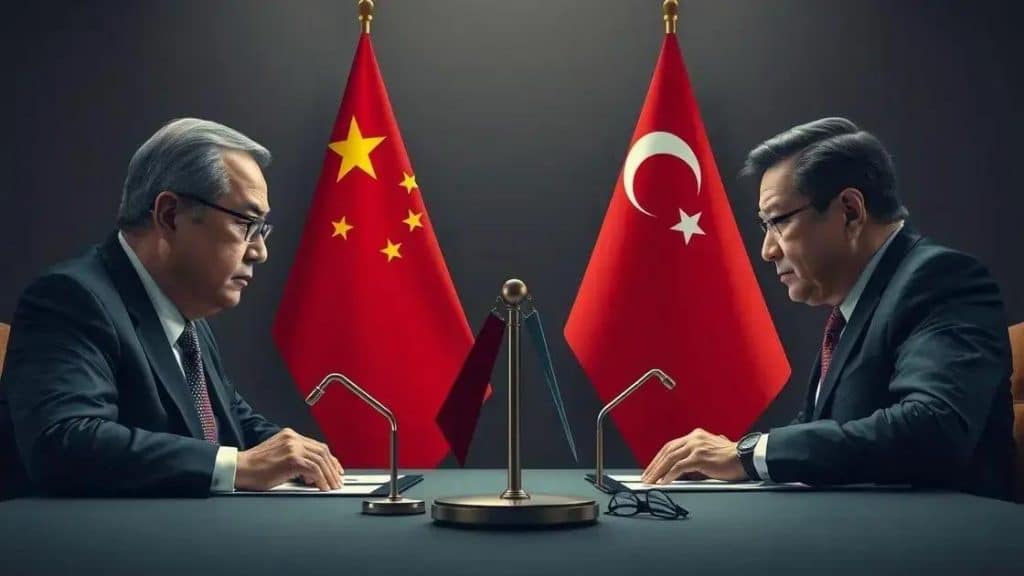IP disputes increase tensions with China

Anúncios
IP disputes increase tensions with China, impacting global trade and diplomatic relations, while the future of IP negotiations requires coordination on enforcement and adapting to technological advancements.
IP disputes increase tensions with China, affecting not only bilateral relations but also global trade. Have you noticed how these conflicts shape the world we live in? Let’s dive deeper into the issue.
Anúncios
Understanding the nature of IP disputes
When discussing IP disputes, it’s essential to grasp their nature and complexity. Intellectual property refers to creations of the mind, such as inventions, literary works, designs, and symbols. These disputes arise when entities clash over rights to use or profit from these creations.
The key types of IP disputes
There are several categories of IP disputes that may arise, each with unique characteristics:
Anúncios
- Patent disputes: These involve disagreements over inventions and the rights to manufacture or sell patented products.
- Copyright disputes: These arise from the unauthorized use of creative works like books, music, and software.
- Trademark disputes: These pertain to conflicts over brand names, logos, and other identifiers of goods and services.
Understanding these types is crucial. Patent disputes often lead to lengthy court battles, while copyright infringements are commonly settled out of court. In contrast, trademark disputes can involve both legal and consumer perspectives.
The role of international law
International law plays a significant role in mediating IP disputes. Treaties, such as the Agreement on Trade-Related Aspects of Intellectual Property Rights (TRIPS), provide guidelines for member countries on how to handle disputes. However, enforcement can vary widely from one country to another.
This inconsistency leads to frustration for businesses operating globally. Companies must navigate not only their local IP laws but also the international landscape, making it crucial to stay informed about varying standards and protections.
As businesses expand globally, understanding the intricacies of IP disputes becomes increasingly important. Awareness can prevent costly litigation and help maintain competitive advantages.
The economic implications of IP conflicts

The economic implications of IP conflicts are profound and can impact various sectors significantly. When companies engage in disputes over intellectual property, it affects not just the parties involved, but the broader economy as well.
Impact on businesses
Intellectual property conflicts can result in several challenges for businesses, including:
- Loss of revenue: Companies may lose profits while a dispute is ongoing, particularly if they cannot sell their products.
- Increased legal costs: Legal battles can be expensive and can drain resources from innovation and growth.
- Market uncertainty: Ongoing disputes can create uncertainty in the market, affecting investor confidence.
These economic factors can reduce overall productivity in affected industries, leading to decreased innovation and market competitiveness.
Global trade consequences
On a larger scale, IP conflicts can lead to tensions in international trade. Countries may impose tariffs or sanctions in retaliation for perceived intellectual property violations. This can disrupt trade flows and lead to economic instability.
For instance, if one country believes that its IP rights are not being respected by another, it may take legal action or pursue resolutions through international bodies. This can complicate diplomatic relationships and create ripple effects throughout the global economy.
Moreover, businesses operating internationally must navigate these conflicts carefully, as varying laws and regulations can significantly alter their operations and strategies.
Understanding the economic implications of IP conflicts is crucial for businesses to adapt and develop contingency plans. By being proactive, companies can protect their interests and ensure their long-term success amid these challenges.
China’s response to international IP pressures
China’s response to international IP pressures has evolved over the years. As one of the world’s largest economies, China has faced scrutiny from various countries regarding its intellectual property rights. This attention comes from concerns about technology transfer and market access.
Government policies
The Chinese government has implemented several policies to address these pressures. Recent changes aim to strengthen IP protection and enhance enforcement mechanisms. These policies reflect a desire to innovate and improve the country’s global standing.
- New legislation: New laws have been introduced to tighten protections for patents, trademarks, and copyrights.
- Investment in technology: China has increased investment in research and development, aiming to create homegrown innovations.
- International cooperation: China has sought partnerships with foreign nations to enhance its IP framework.
This approach shows a commitment to reforming its reputation on the global stage. However, challenges remain in enforcing these changes consistently across the country.
Impact on international relations
The ongoing IP pressures have created a complex landscape in international relations. China’s response has led to both positive and negative reactions from other countries. Some nations appreciate China’s efforts while others remain skeptical, often due to past experiences.
Countries such as the United States have expressed concerns, leading to trade negotiations and tariffs. These tensions emphasize the role that IP issues play in diplomatic relations.
As China continues to navigate these pressures, its approach will be crucial for maintaining trade relationships and fostering a sustainable economic environment. Understanding how China responds can provide insights into future international IP dynamics.
Future prospects for IP negotiations

The future prospects for IP negotiations are full of potential changes as countries adapt to a rapidly evolving global landscape. Emerging technologies, such as artificial intelligence and blockchain, are transforming how intellectual property is created, shared, and protected.
Trends in global IP policies
One significant trend is the increasing collaboration among countries to develop a more uniform framework for intellectual property rights. Several nations are engaging in dialogues to harmonize their laws and practices.
- International treaties: Countries are looking to strengthen existing treaties and potentially create new agreements that address current IP issues.
- Cross-border cooperation: Partnering with international organizations to streamline IP enforcement and increase efficiency.
- Focus on digital rights: As digital content becomes more prevalent, negotiations are shifting to include protections for online assets.
These trends show that nations recognize the importance of protecting innovations while fostering collaboration for economic growth.
Impact of technological advancements
Technological advancements also play a critical role in shaping the future of IP negotiations. New technologies have the potential to streamline processes, enhance tracking, and improve enforcement. For example, blockchain technology can provide transparent records of IP ownership, helping to reduce disputes.
As countries explore these technologies, they also face challenges in creating regulations that encourage innovation without stifling creativity. Ensuring that laws keep pace with technology will be essential for effective IP management.
The dynamic nature of the global economy means that future IP negotiations will require flexibility and adaptability. Countries must balance national interests with global collaboration to create a framework that works for everyone involved.
FAQ – Frequently Asked Questions about IP Disputes and Future Negotiations
What are the key trends in international IP negotiations?
Countries are increasingly collaborating to create uniform IP frameworks and strengthen protections.
How do technological advancements affect IP management?
New technologies like blockchain are enabling better tracking and enforcement of intellectual property rights.
Why is international cooperation important for IP issues?
International cooperation helps streamline IP laws, making it easier for businesses to operate globally.
What is the significance of protecting innovations?
Protecting innovations is vital for economic growth and encourages continued investment in research and development.





